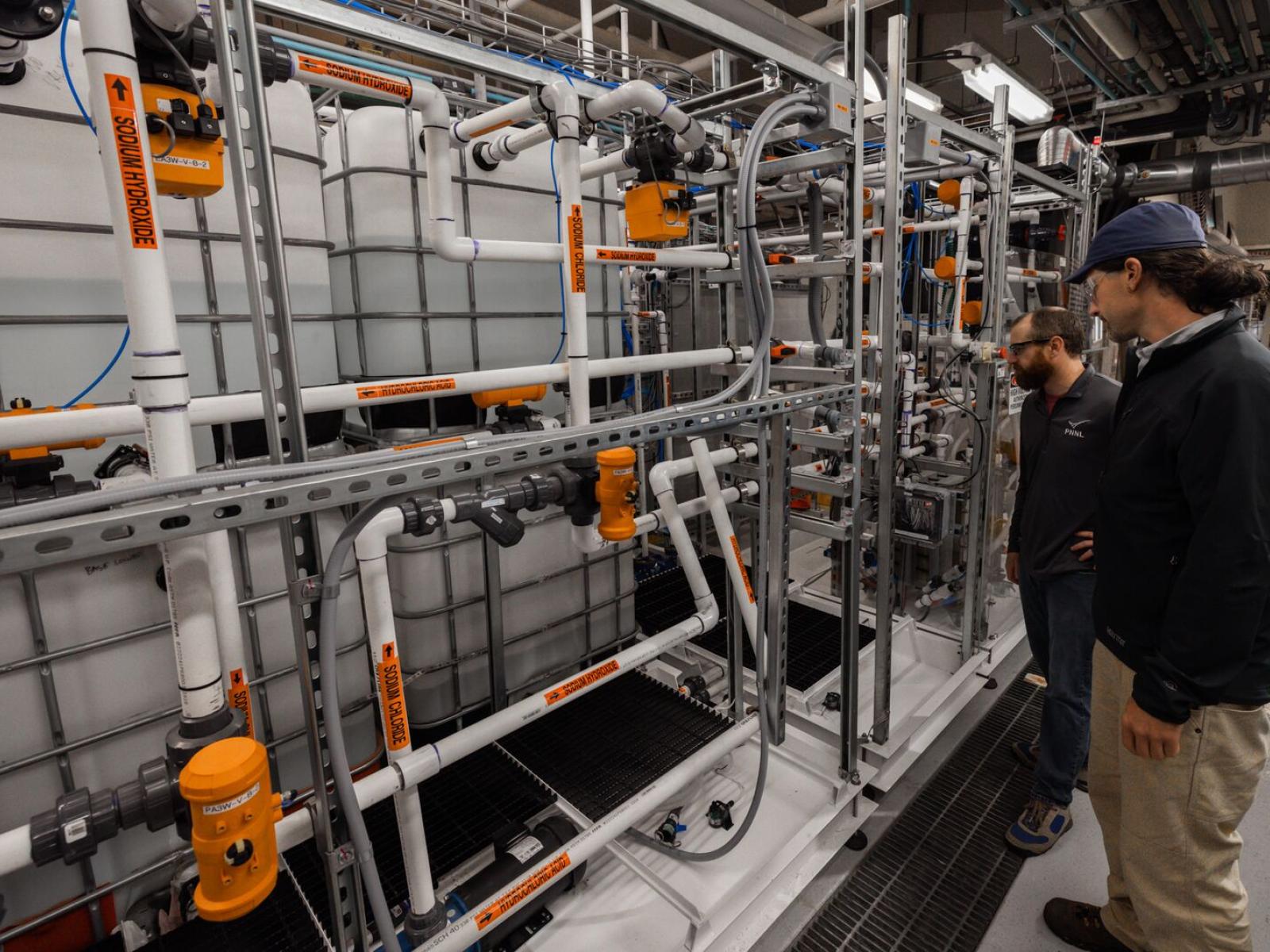New Technology Removes Acid from the Ocean to Sequester Carbon
PNNL-Sequim scientists will test a new technology that could help the ocean soak up carbon dioxide

Ebb Carbon's technology will electrochemically remove acid from seawater, allowing it to absorb more carbon dioxide without adding to ocean acidification.
(Photo by Graham Bourque | Pacific Northwest National Laboratory)
In the fight to slow climate change, the ocean might be humanity’s biggest ally.
Scientists at the Pacific Northwest National Laboratory’s (PNNL) campus in Sequim, Washington, are partnering with Ebb Carbon, the National Oceanic and Atmospheric Administration’s Pacific Marine Environmental Laboratory, and the University of Washington to investigate a new technology that harnesses the ocean’s capacity to absorb carbon dioxide—while protecting its inhabitants from ocean acidification. The project, led by the Pacific Marine Environmental Laboratory, is called Electrochemical Acid Sequestration to Ease Ocean Acidification and has the potential to remove 100 tons of carbon dioxide (CO2) from the atmosphere per year (that’s equivalent to about 112,000 pounds of burned coal).
Earth’s oceans absorb about a quarter of the CO2 that human industries pump into the atmosphere, making it a significant carbon sink. “A cup of ocean water can hold 150 times the amount of carbon dioxide as a cup of air,” said Nick Ward, an Earth scientist at PNNL-Sequim and lead scientist on the PNNL side of the collaboration.
This phenomenon offers a potentially world-changing opportunity to use the ocean to remove more CO2 from the atmosphere and stave off the effects of climate change.
Removing carbon while de-acidifying
Unfortunately, the mission isn’t so simple. When CO2 dissolves in seawater, chemical reactions cause the release of hydrogen atoms, which lowers the water’s pH (increasing acidity). And that acidic water eats away at the calcium-carbonate-based shells of corals and other sea life. This process is known as ocean acidification.
To tackle these conflicting problems, researchers at the carbon sequestration technology company Ebb Carbon developed a system that can remove acid from seawater. Once acid is removed, seawater can then absorb more CO2 without the risk of further acidifying critical ecosystems.
To test their technology on a larger scale, Ebb Carbon recently installed and began operating their equipment at PNNL-Sequim—the only national laboratory campus with marine research facilities and direct access to seawater. Over the next year, PNNL-Sequim researchers will test the validity of Ebb Carbon’s system and study how the alkaline seawater it produces affects ocean ecosystems. They’ll also study the potential to power the system with marine energy from ocean waves, tides, or currents.
“We're not just providing a facility. We’re providing the scientific expertise needed to test how technologies like this can be scaled up to a level where they can make an impact on the amount of carbon dioxide in the atmosphere without adversely influencing ecosystems,” Ward said.
At PNNL-Sequim, Ebb Carbon’s system will electrochemically remove acid from seawater pumped into open-air tanks from Sequim Bay. The process starts with seawater being pumped across a series of electrically charged membranes that separate the seawater into acidic and alkaline solutions.
The alkaline solution (with a higher pH), will then be pumped into different seawater-filled tanks so researchers can observe the effects. As the seawater absorbs CO2, its pH should drop down but not become acidic.
When the seawater’s pH balances out, “we’ll have removed the acid and physically stored more inorganic carbon in the ocean,” Ward said. “We're kind of doing the reverse of burning fossil fuels. We're speeding up the rate that the ocean can take in carbon dioxide.”
Protecting ecosystems
PNNL-Sequim researchers aren’t just investigating the CO2 removal itself—they’re also looking at how the treated, alkaline seawater will impact ecosystems. In other tanks in the laboratory, researchers grow eel grasses, oysters, and other small sea creatures, like isopods and snails, where they will study how these organisms react to alkaline seawater.
To make the overall process sustainable, Ebb Carbon is also investigating partnerships with local industries who have use for the acid removed from the ocean
Once researchers understand how technologies like those developed by Ebb Carbon can sequester carbon while keeping ecosystems safe, the technology can start to scale up and hopefully provide a solution for removing excess carbon dioxide from the atmosphere.
“Given the realities of climate change, it’s critically important that we act quickly to deploy solutions to remove excess CO2 from the atmosphere,” said Ben Tarbell, co-founder and CEO of Ebb Carbon. “But it’s equally important that we do this in a way that is transparent and facilitates public dialogue so that scientists, researchers, policymakers, and communities have visibility into the process. We welcome the opportunity to work with some of the world’s leading scientists and researchers to build the foundations to scale our technology.”
This work was supported by the U.S. Department of Energy’s Water Power Technologies Office, Climate Works and the National Oceanic and Atmospheric Administration’s Ocean Acidification Program.
Published: August 21, 2023